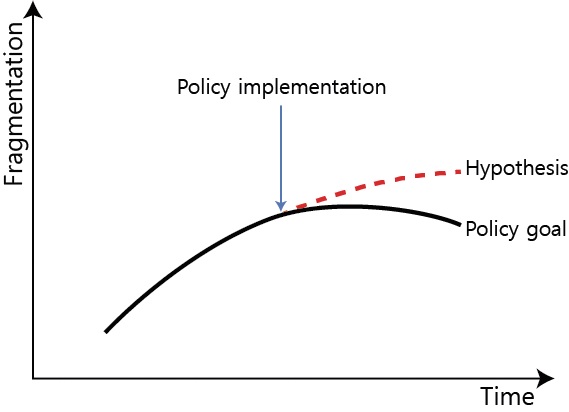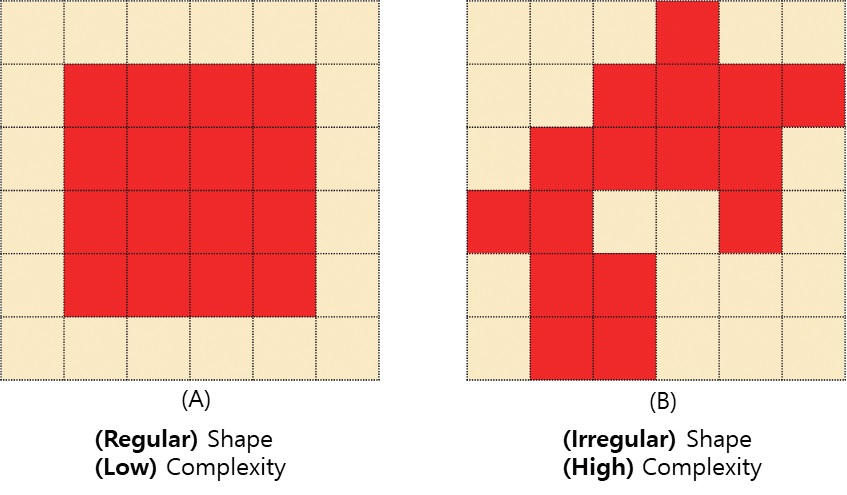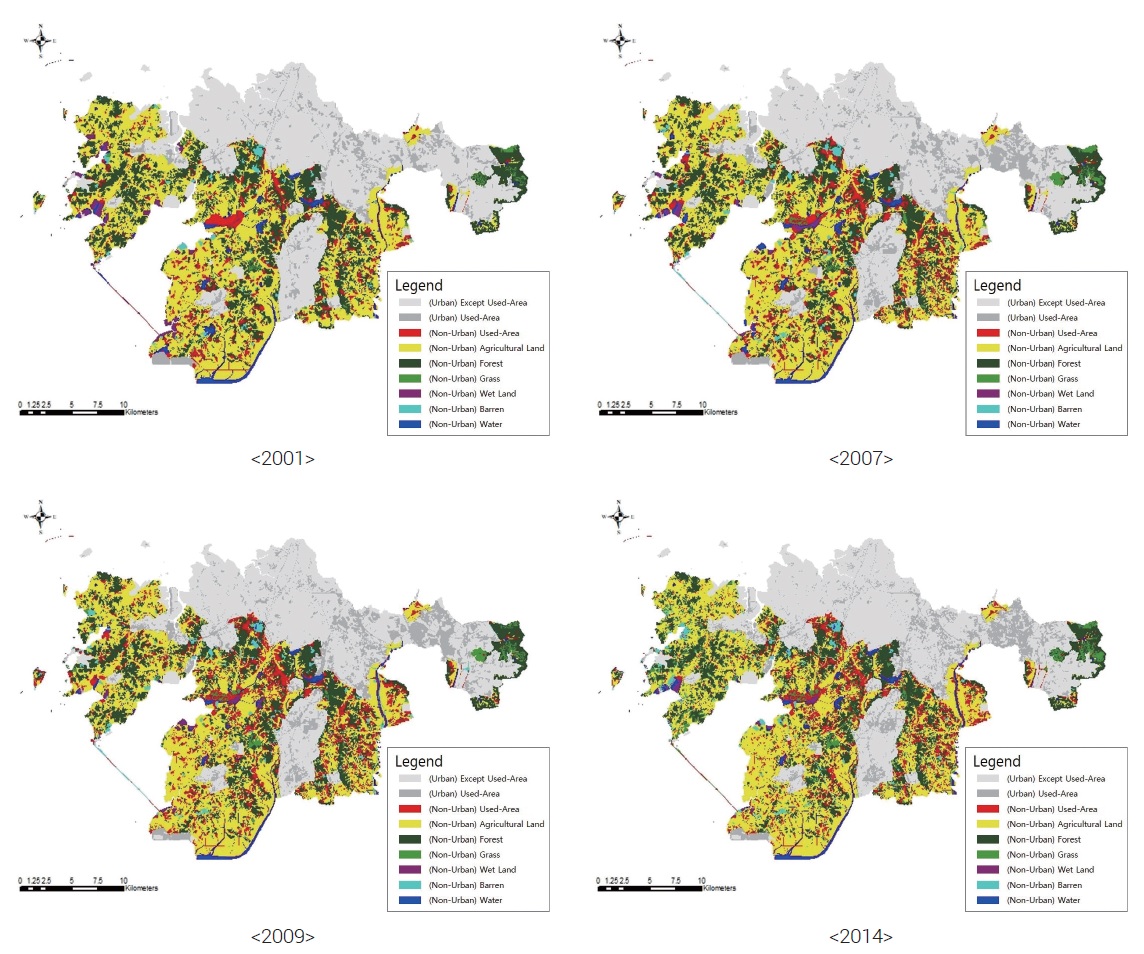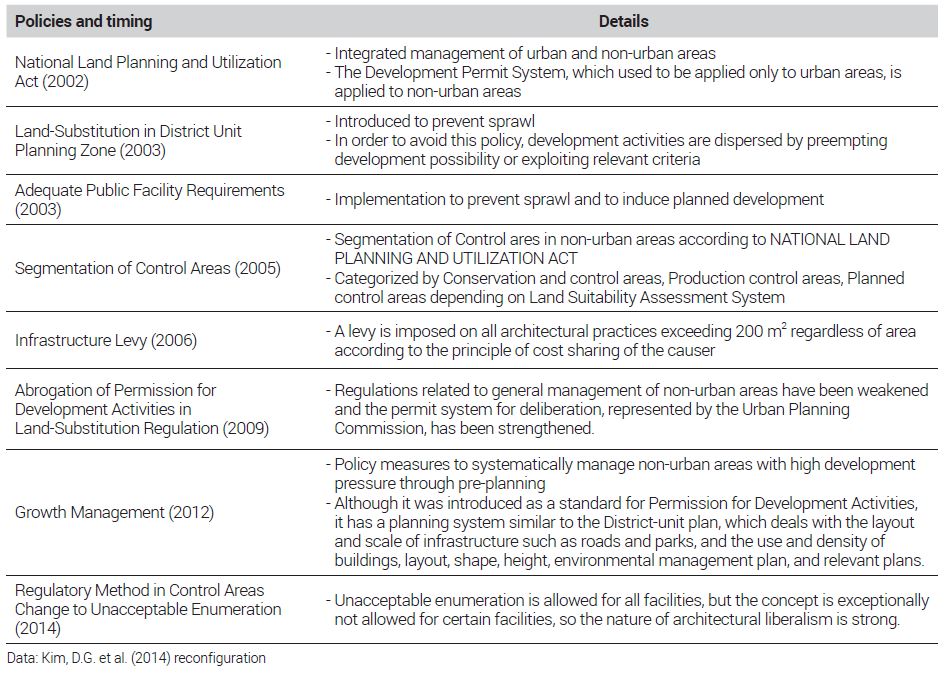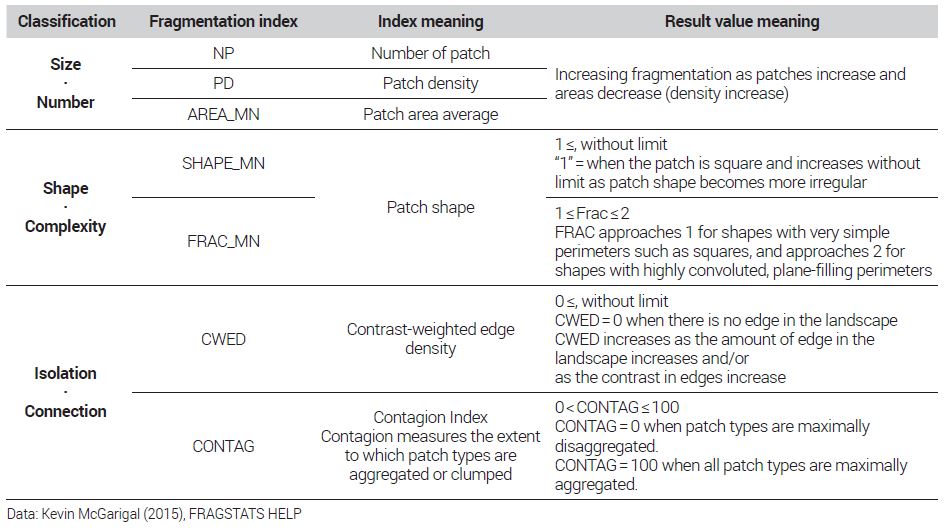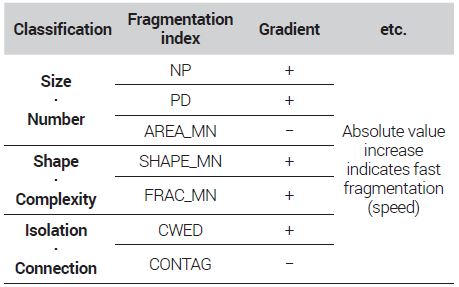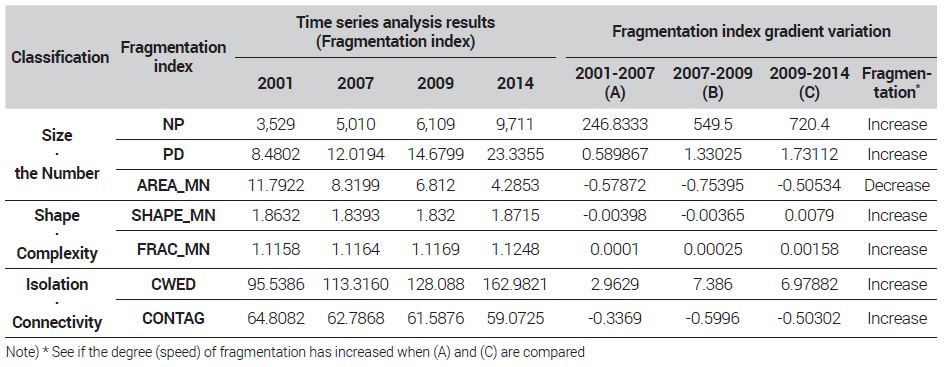
Final publication date 21 Apr 2020
Segmentation of Control Areas and Land Fragmentation in Non-Urban Area : Focusing on Hwaseong
Abstract
The purpose of this paper is to examine the effect of management policy by looking at changes in land fragmentation in non-urban areas. This study defines and analyzes the phenomena of land fragmentation and sprawl in non-urban areas, which are critical in the policy. We have examined changes in land patterns before and after the period when the Segmentation of Control areas policy was enforced. We selected Hwaseong City as the subject of the research and then focused on the Used-Areas, one of the seven categories in the Land Cover Maps of 2001, 2007, 2009, and 2014, to examine the changes in land-cover fragmentation patterns. Fragstats program was used to quantitatively analyze the fragmentation pattern of land. Through a literature review, we selected seven indices related to (1) the size and the number of land patches, (2) the patch shape and complexity, and (3) the isolation and connection caused by fragmentation. Quantitative values were used to investigate the changes in value before and after 2008.
The indices related to the size and the number of the land patches in the Used-Areas show that there were more subdivisions and smaller developments after 2008 than before. The shapes of patches became more complex after the policy period but one thing to note is that the values don’t have a dynamic range. The values of the indices related to isolation and connectivity indicate that more patches were isolated and had less connection in 2009–2014 than in 2001–2007. These results show that sporadic development of small scale has continued to occur even after the implementation of the Segmentation of Control areas policy.
Keywords:
Non-Urban Area, Segmentation of Control Areas, Sporadic Development, Sprawl, Land Fragmentation키워드:
비도시지역, 관리지역세분화, 산발적 개발, 난개발, 토지 파편화Ⅰ. Introduction
1. Research background and purpose
Sustainable development and compact cities have emerged as worldwide trends, contributing to the efficient utilization of cities and blocking the expansion of non-urban areas (Welbank, 1996; Kim et al., 2007). Korea, however, is relaxing regulations on urban planning following the implementation of more lenient policies.
In 2015, the Ministry of Land, Infrastructure and Transport permitted factories for more businesses and relaxed regulations on building-to-land ratio. In 2016, developed sites were designated as district unit plan areas in accordance with relevant laws. The ratio of areas requiring conservation was increased from 20% to 50%, and the amended provisions mitigated the development of non-urban areas. However, this was reported by the press as a move aimed at expanding planned development of non-urban areas (Ministry of Land, Infrastructure and Transport, 2016).
In 2002, the National Land Planning and Utilization Act was enacted for the purpose of facilitating planned development of non-urban areas, and various policies such as restriction on adjacent development, infrastructure integration, segmentation of control areas, and growth management were subsequently implemented. However, policies pertaining to urban areas were not fully carried out due to the trend of regulatory relaxation and complaints from residents. Such policies were also criticized for not effectively preventing the sporadic development of non-urban areas. In addition to addressing the aforementioned issues, researchers have examined and verified related phenomena. The unplanned development of non-urban areas was analyzed in terms of number of development permits (Kim D.G. et al., 2014) and distribution of factories in footloose locations (Lee and Kwon, 2012). Past studies that verified the occurrence of unplanned development in non-urban areas mostly looked at facility distribution and number of development permits. As such, they are limited in discussing changes in the overall space of non-urban areas.
Other countries are aware of landscape changes due to urbanization and the spread of urbanization to suburban areas, and have been making related observations. Some researchers have examined the degree of non-urban area sprawl and land changes based on observations of landscape pattern changes using satellite data (Luck and Wu, 2002; Huang et al., 2009; Shrestha et al., 2012). Land use patterns are related to facility fees, social separation, and resource value (Randolph, 2004; Irwin and Bockstael, 2007). Against this backdrop, land fragmentation is seen as a worldwide issue (Shrestha et al., 2012). The fragmentation patterns of land are used as an indicator of the effectiveness of non-urban area management policies, and as evidence of sprawl in non-urban areas (Lewis et al., 2012).
This study examined the criticism that unplanned development has increased despite the enforcement of non-urban area management policies. In addition, it analyzed changes in non-urban areas instead of simply verifying the occurrence of sprawl in non-urban areas. As such, the effectiveness of non-urban area management policies was assessed through a comparison of land fragmentation before and after policy implementation.
Ⅱ. Non-urban Area Policy Theories and Sprawl-related Literature Review
1. Review of sustainable cities
Extensive research is ongoing around the world on forms of sustainable cities (Welbank, 1996; Kim et al., 2007). Basic requirements are high density of urban areas, pedestrian-friendly development, and development efforts that do not cause harm to natural resources. As such, the basic factors be considered in urban planning are high connectivity, proximity, and density (Calthro, 1993; Duany et al., 2000; Brody et al., 2013). The ideal form of sustainable cities is to develop existing sites rather than proposing new compact cities (Jabareen, 2006). EPA (2001) found that urban forms contribute to land consumption, habitat fragmentation, and impermeable areas, and that they have an impact on the ecosystem and natural environment. High-density development and acquisition of open spaces are thus prioritized for the purpose of energy-saving and green space conservation.
At the same time, sustainable cities are intended to prevent the development of non-urban areas. Urban development results in irreversible land fragmentation. For sustainable development, special attention should be paid to changes in land use in peri-urban zones. In this context, the academia is also focusing on urban land use of non-urban areas (Tan et al., 2006; Huang et al., 2009; Živanović-Miljković et al., 2012).
2. Trends of local non-urban area management policies and criticism of control area segmentation
Non-urban area management policies began from an awareness of problems caused by rapid urbanization. With rapid urbanization in the 1990s, the space for internal development reached its limit. This led to blind development of suburban areas, and non-urban area control plans and policies were implemented in response. In 1994, the Korean government divided land into five areas: urban areas, quasi-urban areas, agricultural and forest areas, quasi-agricultural and forest areas,1) and natural environment conservation areas. Lee (1994) criticized the introduction of quasi-agricultural and forest areas as limiting certain acts but broadening the scope of other permissible acts. In addition, land development was found to have accelerated. The area of quasi-agricultural and forest areas increased by 10-20% each year until 1997, and local governments introduced provisions permitting the opening of restaurants and accommodations. Sporadic development took place in this process, resulting in problems such as lack of infrastructure, landscape damage, environmental pollution, and encroachment of farmland (Sim, 1995; Park, 2000; Seo, 2000).
The government then presented policies for non-urban areas like (Table 1). Aware of the problems of unplanned land use, the government implemented the National Land Planning and Utilization Act for systematic management of non-urban areas from January 2003 onwards. The scope of spatial planning was thus expanded from urban areas to non-urban areas (Kim, D.G. et al., 2014).
Moreover, development permits, segmentation of control areas, infrastructure levy, growth management, industrial complexes, factory cluster district designation, were proposed as management policies for non-urban areas. However, sprawl could not be prevented due to the ambiguous criteria of policies and complaints from residents, and provided the legal basis for building of factory clusters (Kim and Park, 2014) (Table 1).
Development permits and infrastructure levy were abolished as a result of complaints and political changes. Among non-urban area management policies, the only policy that remains in effect is the control area segmentation policy. Under the National Land Planning and Utilization Act, areas exhibiting urban and non-urban characteristics were segmented based on the area/district system. Land suitability assessment was performed to determine the need for conservation or development, and areas were divided accordingly into conservation management areas, production management areas, and planned management areas.
However, the segmentation of control areas faced criticism for not preventing sporadic development of non-urban areas. The policy was implemented without proper understanding of the system, and planned management areas were designated in excess, deviating from the original purpose of the policy. According to urban planning statistics of the Korea Land & Housing Corporation, planned management areas made up about 42.5% to 44.5% of control areas from 2009 to 2018. Sprawl was further aggravated by the designation of small-scale development sites as planned management areas (Chae, 2006).
Another issue raised was the process of segmentation of control areas. The two criteria of conservation areas in land suitability assessment were ecological zoning maps and forest type maps, and there was a lack of consideration for the conservation value of regions, including protected species. Special-purpose areas are segmented based on the results of land suitability assessment, and the purpose may change depending on land area (Sung, 2010). The inaccuracy of basic data of land suitability assessment was also noted (Lee et al., 2007).
3. Research on sprawl analysis in non-urban areas
While sprawl can be defined in many ways, it is used in the context of unplanned development or un-serviced development in Korea (Jung and Kim, 2003; Seo, 2008; Lee and Kwon, 2012; Kim, 2015). Non-urban area management policies are mainly criticized for contributing to sprawl.
In addition to criticism, researchers have analyzed sprawl in non-urban areas. Lee and Kwon (2012) analyzed the distribution patterns of unplanned, footloose factories following the implementation of quasi-agricultural and forest area policy. They also developed a technique of monitoring changes in footloose factory sites. Lee and Hwang (2012) examined the development of non-urban areas in Gyeonggi-do Province by analyzing the number of development permits and area of permitted development. Case studies of non-urban area development were reviewed through Hwaseong’s development permits for non-urban areas, status of planned development sites (area, number), and distribution of buildings near roadsides and mountains (floor space, number). Lee and Jung (2012) perceived the number of development permits as the key issue behind sprawl, and analyzed related problems based on number of development permits and spatial distribution. Lee et al. (2015) confined their study of sprawl to the mixing of factories and residential spaces in planned management areas, and utilized the landscape index. Local research on sprawl in non-urban areas have demonstrated sprawl through specific facilities or development acts, including distribution of factories and number of development permits.
Overseas research have focused on changes in land use patterns in non-urban areas due to sprawl. To verify the expansion of cities, changes in land use and land surface in suburban and city-agricultural districts were observed. Land fragmentation was verified through the occurrence of sprawl, as indicated in land pattern changes (Forman, 1995; Seto and Fragkias, 2005). Huang et al. (2009) showed that forest and agricultural areas were undergoing rapid urbanization because of sprawl, and that fragmentation was more severe in unplanned areas than planned areas. Luck and Wu (2002), and Irwin and Bockstael (2007) attributed sporadic development and land fragmentation in non-urban areas to urban expansion. Overseas researchers have demonstrated sprawl mainly through observations of land changes in non-urban areas, in particular, the fragmentation of land designated for urban use or conservation.
4. Fragmentation phenomenon of non-urban areas
Development expanding from urban to non-urban areas cause sporadic spreading of land patterns. Sprawl has caused small-scale and sporadic development, and encroached on green spaces and agricultural land in suburban areas. Finescale patterns were formed in this process. Fine-scale patterns increase infrastructure service fees and lower the efficiency of land use from a public and community perspective (Irwin and Bockstael, 2007; Kim, 2015). They also lead to problems such as lack of infrastructure, landscape damage, environmental pollution, and farmland encroachment (Sim, 1995; Park, 2000; Seo, 2000).
The above phenomenon is known as land fragmentation. Fragmentation is the process of breaking up and isolating habitats, ecosystems or land into smaller parts, and induces changes in land patterns through spatial changes (Forman, 1995). Land fragmentation can be explained as two phenomena. First, it is the division of a space into smaller parts (Luck and Wu, 2002. Kim, D.H. et al., 2014). Second, it refers to complex, geometric spatial changes (Mcgarigal, 2015).
From the perspective of environmental change, the fragmentation of non-urban areas cause problems such as threats to habitats, deterioration of the value of natural resources, and removal of open space functions (Irwin and Bockstael, 2007).
Land fragmentation is identified as one of the causes of change in land use, and is influenced by land changes. As such, it is used to analyze discontinuous land use, land surface conversion, and leap-frog development in urbanization research (Luck and Wu, 2002.; Kim, D.H. et al., 2014). Also, it is utilized as an indicator of the effectiveness of management policies implemented for non-urban area (Lewis and Knaap, 2012).
Land fragmentation patterns of non-urban areas thus serve as a basis for observations of non-urban sprawl, and as an indicator of the effectiveness of policies implemented to prevent sprawl in non-urban areas.
5. Sub-conclusion
Past research showed that the expansion of non-urban areas is being blocked to achieve sustainable development, and that compact cities are favored as a result. However, Korea has seen an expansion of non-urban areas, and policies implemented for planned development of non-urban areas have in fact led to sprawl. Despite these circumstances, few domestic studies exist on overall spatial changes and sprawl in non-urban areas.
In overseas studies, sprawl occurring in the direction from cities to non-urban areas was observed, and land pattern changes were used to assess the effectiveness of smart policies in agricultural areas. An analysis of land surface pattern changes revealed that land surface patterns experienced fragmentation in both non-urban and suburban areas with the change in land use.
Korea has relaxed regulations on land use; this relaxation, in reality, works against plans for sustainable development of non-urban areas. This study seeks to investigate changes in land surface in non-urban areas to determine the effectiveness of non-urban area management.
The purpose of this study was to examine the land fragmentation resulting from expansion of urban areas as observed in past research. The effectiveness of policies were assessed based on circumstances before and after the implementation of the segmentation of control areas policy, intended to prevent sporadic development of non-urban areas. Overall spatial patterns were studied through changes in land fragmentation in non-urban area exhibiting urban characteristics. The research question and hypothesis derived from past studies are as follows.
- Question: Did the implementation of the segmentation of control areas policy in non-urban areas delay the rate of sporadic development in such areas?
- Hypothesis: Non-urban areas would have seen an increase in land fragmentation even after the implementation of the segmentation of control areas policy.
If the segmentation of control areas was implemented according to the policy goal, the rate of fragmentation should decrease as marked by the solid line in Figure 1. That is, the gradient should decrease after the point of policy implementation. If local governments consider the planned development of non-urban area, there will be patches2) with larger average sizes, more regular planned faces, and patches with stronger connectivity.
If the segmentation of control areas policy fails to achieve the intended goal, fragmentation will continue to increase as indicated by the dotted line in Figure 1.
Ⅲ. Analysis of Land Fragmentation after the Implementation of Segmentation of Control Areas Policy in Non-urban Areas
1. Method of analysis and scope of research
To examine whether the non-urban area management policy is being properly implemented, this study looked at changes in land patterns before and after the enforcement of the segmentation of control areas policy. In particular, this study measured the degree of land fragmentation occurring during sporadic development. Land cover maps provided by the Ministry of Environment were used to quantify landscape connectivity, and Fragstats was employed to analyze landscape indices. Land fragmentation was analyzed based on patch distribution, shape and spatial arrangement.
Land surface was categorized into seven items according to land features. To examine urban land use patterns in non-urban areas, this study focused on pattern changes in built-up areas.
Administrative boundary data and zoning data provided by KLIS in 2016 were used to classify Hwaseong’s urban and non-urban areas (agricultural, management, natural environment conservation areas). To utilize Fragstats, land surface vector data were rasterized. Here, data were produced in the spatial resolution of 5 m×5 m.
Based on related reports and statistical data, Hwaseong was selected as the subject of this study as its non-urban areas are undergoing sporadic development. Hwaseong is included among the growth management cities in the metropolitan area. In terms of land use, non-urban areas account for the majority, and among them, control areas constitute 61.31% (UPIS, as of 2014).
Hwaseong implemented the segmentation of control areas policy in 2008. To assess the effectiveness of the non-urban area policy, this study analyzes land pattern changes in non-urban areas before and after 2008. The time period of analysis in past research was selected according to special events or planning periods within the scope of available data (Yu and Ng, 2007; Shi et al., 2012). Seto and Fragkias (2005) and Shrestha et al. (2012) conducted a time-series analysis before and after the implementation of policies. In order to examine the effect of the segmentation of control areas policy, this study compared the results before and after 2008. Considering the available land surface data of the Environmental Geographic Information Service (EGIS), the years 2001, 2007, 2009 and 2014 were selected for this study. Fragmentation indices and gradients (change in index/time) were compared between different time periods using Fragstats to assess the effectiveness of the segmentation of control areas policy.
2. Selection of fragmentation index
Considering past research and the definition of fragmentation, fragmentation indices were selected to facilitate the analysis of changes in size and number of land patches, shape and complexity, and isolation and connectivity.
Based on past research on changes in land surfaces in non-urban areas, this study selected seven indices. Fragstats 4.2 manual, which describes the fragmentation indices and meanings, is shown in Table 2.
The number of patches and increase in patch density can be determined by NP and PD, and the area of patches that decrease due to fragmentation by AREA_MN. As fragmentation progresses, patches with smaller areas, higher numbers and higher densities are observed. Figure 2 shows development for the same area, but (B) has more patches and a higher density than (A), and a smaller average patch area. SHAPE_MN and FRAC_MN represent patch shape, complexity, and irregularity. SHAPE represents the complexity of a face, while FRAC shows the complexity of a side. If both values are equal to or greater than 1, the results are shapes with simple perimeters (or squares). The maximum value of SHAPE is infinite, while that of FRAC is 2. Figure 3 shows the same area, but (B) has a more irregular and complex pattern compared to (A).
CWED and CONTAG represent the isolation and connection of patches. CWED becomes larger as the contrast in edges increases. CONTAG represents the spatial aggregation of patches, and a value closer to 0 indicates greater segmentation and less connectivity. In Figure 4, the pattern in (B) is more isolated and less connected than (A). (B) shows more contrast in edges than (A), and exhibits a dispersed pattern.
The gradient of indices in relation to their meanings are presented in Table 3. The gradients assume the value of either + or –. For AREA_MN and CONTAG, smaller values indicate more fragmentation. When comparing data between two points, a negative gradient means an increase in fragmentation. For the other five indices, fragmentation increases when the gradient is positive. The absolute value of the gradient is the degree of fragmentation (rate). A higher fragmentation rate means that fragmentation occurred at a faster speed.
3. Analysis results
The base year of analysis for this study was set as 2008, when the non-urban area segmentation was implemented in Hwaseong, to examine whether the purpose of preventing sprawl in non-urban areas has been achieved. The fragmentation indices and changes between time periods (2001-2007, 2007-2009, 2009-2014) were examined for four periods: “before the segmentation of control areas (2001, 2007)” and “after the segmentation of control areas (2009, 2014).”
The fragmentation indices of the four points, as presented in Table 4, can be analyzed as follows. From 2001 to 2014, the number of patches (NP) of urban areas and patch density (PD) increased, while average area (AREA_MN) decreased. From examining the size and number of patches, the fragmentation of urban land use can be seen as increasing.
For shape and complexity, the changes were not as significant. The shapes in 2007 and 2009 were more regular than that of 2001, but irregular development was observed in 2014.
Contrast-weighted edge density (CWED) increased over time, and this implies an increase in isolation. The decrease in CONTAG, which represents spatial aggregation, reflects the dispersed land patterns.
The changes in the seven fragmentation indices show that urban land use of non-urban areas saw an increase in fragmentation patterns despite the 2008 enforcement of segmentation of control areas. Moreover, the fragmentation phenomenon is evident in the GIS maps of land surfaces in Figure 5.
To analyze changes between points, this study examined the gradient of fragmentation before and after the implementation of the 2008 policy, that is, 2001-2007 (A) and 2009-2014 (C). The change in gradient was also analyzed for 2007-2009 (B), which includes the year of implementation. Table 4 Fragmentation Index Gradient Variation and Figure 6 are the result values.
First, the gradients of NP, PD, and AREA_MN, which represent the patch size and number of (A) and (C), were examined. The increase in number of patches and change in density were greater during (A), the period before the implementation of the segmentation of control areas policy, than (B), the period after. The average patch area continuously decreased, but the absolute value of (A) (0.57872) was slightly larger than that of (C) (0.50534). Looking at the gradient signs, we can see that fragmentation continued throughout. The rate of increase in patches and density was faster after the policy implementation. The area of patches grew smaller, but at a slower rate.
Looking at the shape and complexity during (A) and (C), SHAPE_MN showed more regular development in (A) with a negative gradient, but became irregular in (C) with a positive gradient. The absolute value of FRAC_MN, which represents the boundary complexity, grew larger during (C). This can be interpreted as the boundary of development areas having faster complexity rates.
The gradient of CWED, which represents isolation, was positive at both (A) (2.9629) and (C) (6.97882). This means that the rate of development of isolated shapes was faster during (C). From the change in CONTAG, we can see that the drop in connectivity of non-urban areas non-urban area accelerated after 2008.
SHAPE_MN had a negative gradient during (B), which includes the year of implementation of the segmentation of control areas policy. It can be thus presumed that there was more regular development than before. Fragmentation was more severe in all other periods after the implementation of the segmentation of control areas policy. In other words, there was more fragmentation in 2009 than in 2007. AREA_MN (average patch area) declined at the steepest decline, meaning that small-scale development occurred most rapidly during this period.
This study was conducted to determine whether the implementation of the segmentation of control areas policy contributed to slowing sporadic development in non-urban areas. Based on criticism of the control area segmentation policy in past research and findings on land changes of overseas non-urban areas, this study tested the hypothesis that fragmentation of non-urban areas would have increased following the implementation of the segmentation of control areas policy. The results showed that fragmentation increased continuously during the four points (2001, 2007, 2009, 2014). In addition, fragmentation accelerated in the period after the policy implementation than before, or specifically, 2009-2014 than 2001-2007. During the transition years from 2007 to 2009, the change in fragmentation indices indicate a noticeable decrease in average land area. This means that small-scale development took place rapidly around the time of enforcement of the segmentation of control areas policy.
Ⅳ. Summary and Conclusion
In light of the relaxation of regulations concerning non-urban areas, this study examined the fragmentation of non-urban areas to determine whether such regulations are achieving their intended goals. The results showed that Hwaseong has been going through fragmentation following the implementation of the segmentation of control areas policy, and that there has been an increase in sprawl.
This study is limited in its data and spatial range. Since the analysis was conducted using data provided by the National Environment Information Center, it was not possible to obtain data of the same time intervals. In addition, the focus was on urban areas as bare patches and grass pots could not be distinguished. Time-series changes may be observed if land surface data accumulate over time. This study’s methodology can also be useful if data more representative of urban land use become available. Since the subject of analysis was limited to Hwaseong, the results cannot be generalized to sprawl in all non-urban areas. The scope of research should be expanded to other regions in future work, so as to determine whether the segmentation policy is fulfilling its intended purpose.
The various mechanisms preventing the implementation of regulatory policies are limiting the effectiveness of segmentation policy in non-urban areas. Following the segmentation of control areas, the concentration of steady development in planned management areas, lack of infrastructure, and mixing of residential zones and factories have caused environmental and health issues (Lee et al., 2015; Lee and Seong, 2016). Against this backdrop, it is important to analyze the problems and effectiveness of policies implemented for quasi-development sites in non-urban areas.
To assess the effectiveness of policies in non-urban areas, it is necessary to consider their main goals. Policies should pursue cities that allow sustainable development and eco-friendly management, and be consistent with planned developed as described in the National Land Planning and Utilization Act. To achieve this purpose, spatial aggregation of development and conservation areas is essential (Chae, 2006).
Land suitability assessment, conducted for the segmentation of non-urban control areas, must be adjusted as the evaluation criteria are insufficient in representing mobility and conservation (Lee and Sung, 2016). Data presented as an indicator for conservation may contribute to sprawl during segmentation as there is no consideration of environmental connectivity.
The competence of governments and other entities responsible for land use improvement and policy implementation is also important. As pointed out by Ban et al. (2015), non-urban area management policies are implemented at the discretion of local governments. Since 2014, regulations on planned management areas were in a listed form of prohibitions. The relaxation of regulations in terms of land use is expected to place greater emphasis on the review and permit system (Kim, D.G. et al., 2014).
This study can be utilized in two ways. First, it can serve as a methodology of verifying the effectiveness of non-urban area policies. Since non-urban area policies are intended to encourage planned development and conservation while avoiding sprawl, the occurrence of sporadic development can be examined through observations of fragmentation in land assigned to development purposes. The occurrence of land fragmentation will be evidence of unplanned development. If fragmentation is analyzed based on data on conservation areas, the spatial aggregation of such areas can be examined. The assessment of policy effectiveness can be used to make adjustments to unsegmented control areas, or as reference for related authorities and experts in the review of development permits for non-urban areas.
Second, the results can serve as a basis of reviewing land continuity during land suitability assessment. Continuity can be reviewed in the context of development, and land isolation examined by utilizing biotopes and forests. Land fragmentation can be properly diagnosed and further avoided if time-series data are obtained.
Acknowledgments
This paper is a revision of the main author’s master’s thesis, and was supported by grants from the Ministry of Education and the National Research Foundation of Korea (NRF-2016S1A5A2A01026914) in 2016.
References
-
Ban, Y.W., Son, C.H., Baek. J.I., and Han, K.M., 2015. “Analyzing the Distributional Characteristics of Independently-Located Factories in Non-Urbanized Area – Focused on Gimpo City –”, Journal of the Residential Environment Institute of Korea, 13(1): 55-64.
반영운·손철희·백종인·한경민, 2015. “비도시지역 개별입지 분포 특성분석 – 김포시를 대상으로 –”, 「주거환경」, 13(1): 55-64. -
Chae, M.O., 2006. “A Study on the Direction of Subdividing Control Area for the Planned National Territory Management”, KRIHS Policy Brief, (105): 1-8.
채미옥, 2006. “계획적 국토관리를 위한 관리지역 세분화 방향”, 「국토정책 Brief」, (105): 1-8. -
Jung, H.W. and Kim, J.I., 2003. “The Spatial Distribution of Urban Sprawl in Metropolitan Regions”, Journal of Korea Planning Association, 38(5): 7-20.
정현욱·김재익, 2003. “대도시권역 난개발의 공간적 분포에 관한 연구”, 「국토계획」, 38(5): 7-20. -
Kim, C.H., Lee, C.S., and Woo, Y.S., 2007. “Study on Compact City Model for Sustainable New Town Development in Korea”, Journal of Korea Planning Association, 42(2): 49-68.
김찬호·이창수·우윤석, 2007. “지속가능한 신도시 개발을 위한 한국형 압축도시모형 정립에 관한 연구”, 「국토계획」, 42(2): 49-68. -
Kim, D.G., Kim, S.J., Kim, S.S., Lee, B.J., Koo, H.S., and Lee, T.W., 2014. Improvements of Development Permit System for Non-urban Area Addressing the Change of Urban Planning Regulation System, Anyang: Korea Research Institute for Human Settlements.
김동근·김상조·김성수·이병재·구형수·이태웅, 2014. 「도시계획 규제방식 전환에 대응하기 위한 비도시지역 개발행위허가에 관한 연구」, 안양: 국토연구원. -
김동현·서혜정·이병국, 2014. “비도시화 토지의 지속가능한 토지이용을 위한 그린인프라 적용기법: 에코델타시티 사례를 중심으로”, 「대한환경공학회지」, 36(6): 402-411.
Kim, D.H., Seo, H.J., and Lee, B.K., 2014. “Method of Green Infrastructure Application for Sustainable Land Use of Non-urban Area: The Case Study of Eco-delta City”, Journal of Korean Society of Environmental Engineers, 36(6): 402-411. [ https://doi.org/10.4491/KSEE.2014.36.6.402 ]
-
Kim, E.R. and Park. G.H., 2014. “Task for Effective Management of Growth Management in Non Built-up Areas”, KRIHS Policy Brief, 472: 1-6.
김은란·박근현, 2014. “비시가화지역 성장관리방안의 효율적 운용을 위한 과제”, 「국토정책 Brief」, 472: 1-6. -
Kim, Y.H., 2015. “A Study on the Institute for Prevention of Un-controled Development: the case study in Cheongju City”, Journal of The Korean Cadastre Information Association, 17(2): 133-147.
김영환, 2015. “도시 난개발 방지 제도의 운영실태 및 개선방안에 관한 연구: 청주시를 중심으로”, 「한국지적정보학회지」, 17(2): 133-147. -
Lee, J.Y., 1994. “The Effects of Sub-agricultural Areas on Urban Development and Countermeasures – Focused on Capital Region”, Urban Issues, 29(312): 81-94.
이재용, 1994. “준농림지역이 도시개발에 미치는 영향과 대책 – 수도권지역을 중심으로 –”, 「도시문제」, 29(312): 81-94. -
Lee, K.J. and Kweon, I., 2012. “An Empirical Study on Examining the Haphazard Land Use Pattern due to Unplanned Locations of Industrial Firms at the Urban Fringe”, Journal of The Korean Regional Development Association, 24(5): 145-159.
이경주·권일, 2012. “비도시 지역의 공장 개별입지 난개발에 관한 실증적 분석”, 「한국지역개발학회지」, 24(5): 145-159. -
Lee, O.H., Lee, B.S., and Lee, J.E., 2007. A Management Strategy for Suburban Region in Gyeonggi Province, Suwon: Gyeonggi Research Institute.
이외희·이봉석·이지은, 2007. 「관리지역 세분화에 따른 비도시지역의 관리방안」, 수원: 경기연구원. -
Lee, O.H. and Hwang, G.H., 2012. The Management of Non-Urbanized Areas in Gyeonggi-Do, Suwon: Gyeonggi Research Institute.
이외희·황금회, 2012. 「경기도 비도시지역의 정비와 관리방안」, 수원: 경기연구원. -
이왕기·정승현, 2012. “비도시지역 개발행위허가제 운용실태 및 개선방안에 관한 연구: 인천광역시 강화군을 사례로”, 「국토연구」, 73: 203-225.
Lee, W.K. and Jung, S.H., 2012. “A Study on the Operation of Development Permit System in Non-urbanized Areas: Focused on the Ganghwa-gun, Incheon”, The Korea Spatial Planning Review, 73: 203-225. [ https://doi.org/10.15793/kspr.2012.73..012 ]
-
Lee, Y.J., Park, J.H., and Seong, C.Y., 2015. Current Land Development Conditions and Environmental Management Measures in the Plan Management Zone, Sejong: Korea Environment Institute.
이영재·박지현·성찬용, 2015. 「계획관리지역 토지이용 실태분석 및 환경관리방안」, 세종: 한국환경정책·평가연구원. -
Lee, Y.J. and Seong, C.Y., 2016. Development and Application of an Evaluation Measure for Residential-industrial Mixture Type Disordered Development in Suburban Areas, Sejong: Korea Environment Institute.
이영재·성찬용, 2016. 「비도시지역 주거-공장 혼재형 난개발 평가기준 개발 및 활용방안 마련」, 세종: 한국환경정책·평가연구원. -
Park, H.J., 2000. “Problems of Sprawl Measures”, Space and Environment, 14: 214-243.
박헌주, 2000. “난개발 대책의 문제점”, 「공간과 사회」, 14: 214-243. -
Seo, S.T., 2000. “Current Situation and Countermeasures of Sprawl in the Seoul Metropolitan Government’s Quasi-agricultural Area”, Journal of KHRIHS, (226): 6-17.
서순탁, 2000. “수도권 준농림지역 난개발 실태와 대책”, 「국토」, (226): 6-17. -
Seo, S.T., 2008. “A Study on the Improvement of Development Permit System for Preventing Sprawl”, Journal of Gyeonggi, 10(2): 61-74.
서순탁, 2008. “난개발 방지를 위한 개발행위허가제 개선방안”, 「경기논단」, 10(2): 61-74. -
Sim, S.W., 1995. “A Fundamental Study on the Formation of Land Use in Semi-agricultural and Forest Areas”, Journal of Korea Planning Association, 30(3): 17-33.
심상욱, 1995. “준농림지역에서의 토지이용형성에 관한 기초적연구”, 「국토계획」, 30(3): 17-33. -
Sung, H.C., 2010. “A Study on the Environmental Assessment of Development Projects within Management Zone”, Journal of the Korea Society of Environmental Restoration Technology, 13(3): 114-127.
성현찬, 2010. “관리지역 내 개발사업에 대한 환경성 평가방안 연구”, 「한국환경복원녹화기술학회지」, 13(3): 114-127. -
Brody, S., Kim, H., and Gunn, J., 2013. “Examining the Impacts of Development Patterns on Flooding on the Gulf of Mexico Coast”, Urban Studies, 50(4): 789-806.
[https://doi.org/10.1177/0042098012448551]

- Calthrope, P., 1993. The Next American Metropolis: Ecology, Community, and the American Dream, Princeton, NJ: Princeton Architectural Press.
- Duany, A., Plater-Zyberk, E., and Speck, J., 2000. Suburban Nation: The Rise of Sprawl and the Decline of the American Dream, New York: North Point Press.
-
Forman, R.T., 1995. Land Mosaics: The Ecology of Landscapes and Regions, Cambridge: Cambridge University Press.
[https://doi.org/10.1017/9781107050327]

-
Huang, S.L., Wang, S.H., and Budd, W.W., 2009. “Sprawl in Taipei’s Peri-Urban One: Responses to Spatial Planning and Implications for Adapting Global Environmental Change”, Landscape and Urban Planning, 90(1): 20-32.
[https://doi.org/10.1016/j.landurbplan.2008.10.010]

-
Irwin, E.G. and Bockstael, N.E., 2007. “The Evolution of Urban Sprawl: Evidence of Spatial Heterogeneity and Increasing Land Fragmentation”, Proceedings of the National Academy of Sciences, 104(52): 20672-20677.
[https://doi.org/10.1073/pnas.0705527105]

-
Jabareen, Y.R., 2006. “Sustainable Urban Forms: Their Typologies, Models, and Concepts”, Journal of Planning Education and Research, 26(1): 38-52.
[https://doi.org/10.1177/0739456X05285119]

-
Lewis, R. and Knaap, G.J., 2012. “Targeting Spending for Land Conservation: An Evaluation of Maryland’s Rural Legacy Program”, Journal of the American Planning Association, 78(1): 34-52.
[https://doi.org/10.1080/01944363.2011.645275]

-
Luck, M. and Wu, J., 2002. “A Gradient Analysis of Urban Landscape Pattern: A Case Study from the Phoenix Metropolitan Region, Arizona, USA”. Landscape Ecology, 17(4): 327-339.
[https://doi.org/10.1023/A:1020512723753]

- Randolph, J., 2004. Environmental Land Use Planning and Management, Washington, DC: Island Press.
-
Seto, K.C. and Fragkias, M., 2005. “Quantifying Spatiotemporal Patterns of Urban Land-Use Change in Four Cities of China with Time Series Landscape Metrics”, Landscape Ecology, 20(7): 871-888.
[https://doi.org/10.1007/s10980-005-5238-8]

-
Shrestha, M.K., York, A.M., Boone, C.G., and Zhang, S., 2012. “Land Fragmentation due to Rapid Urbanization in the Phoenix Metropolitan Area: Analyzing the Spatiotemporal Patterns and Drivers”, Applied Geography, 32(2): 522-531.
[https://doi.org/10.1016/j.apgeog.2011.04.004]

-
Shi, Y., Sun, X., Zhu, X., Li, Y., and Mei, L., 2012. “Characterizing Growth Types and Analyzing Growth Density Distribution in Response to Urban Growth Patterns in Peri-Urban Areas of Lianyungang City”, Landscape and Urban Planning, 105(4): 425-433.
[https://doi.org/10.1016/j.landurbplan.2012.01.017]

-
Tan, S., Heerink, N., and Qu, F, 2006. “Land Fragmentation and Its Driving Forces in China”, Land Use Policy, 23(3): 272-285.
[https://doi.org/10.1016/j.landusepol.2004.12.001]

- U.S. Environmental Protection Agency (EPA), 2001. Our Built and Natural Environments: A Technical Review of the Interactions between Land Use, Transportation, and Environmental Quality, EPA 231-R-01-002.
- Welbank, M., 1996. “The Search for a Sustainable Urban Form.” in The Compact City: A Sustainable Urban Form?, edited by Mike Jenks, Elizabeth Burton, Katie Williams, 63-70. Oxford: Oxford Brookes University Press.
-
Yu, X.J. and Ng, C.N., 2007. “Spatial and Temporal Dynamics of Urban Sprawl along Two Urban–rural Transects: A Case Study of Guangzhou, China”, Landscape and Urban Planning, 79(1): 96-109.
[https://doi.org/10.1016/j.landurbplan.2006.03.008]

-
Živanović-Miljković, J., Crnčević, T., and Marić, I., 2012. “Land Use Planning for Sustainable Development of Periurban Zones”, Spatium International Review, 28: 15-22.
[https://doi.org/10.2298/SPAT1228015Z]

-
Ministry of Land, Infrastructure and Transport, Department of the City Policy, 2016, Jan 29. “Planned Development of Non-urban Areas Will Be Expanded”, Ministry of Land, Infrastructure and Transport, http://www.molit.go.kr/USR/NEWS/m_71/dtl.jsp?id=95076956
국토교통부 도시정책과, 2016.1.29. “비도시지역의 계획적인 개발 확대된다!”, 국토교통부, http://www.molit.go.kr/USR/NEWS/m_71/dtl.jsp?id=95076956 - Kevin McGarigal, 2015, Apr 21. “FRAGSTATS HELP”, https://www.umass.edu/landeco/research/fragstats/documents/fragstats.help.4.2.pdf
-
UPIS(Urban Planning Information Service), “2014 Urban planning status”, http://upis.go.kr/upispweb/statsmgmt/viewListdown.do
UPIS(도시계획정보서비스), “2014년 도시계획현황통계”, http://upis.go.kr/upispweb/statsmgmt/viewListdown.do

